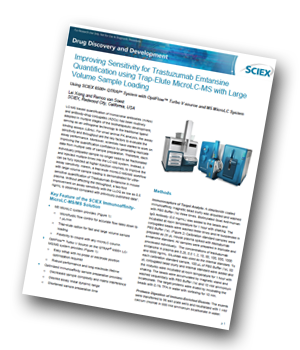This study describes in detail an improved immunoaffinity-micro LC-MS/MS workflow for quantifying trastuzumab emtansine in mouse plasma using the SCIEX 6500+ QTRAP® System with OptiFlow™ Turbo V source and M5 MicroLC System.
 LC-MS based quantification of monoclonal antibodies (mAbs) and antibody-drug conjugates (ADCs) has been routinely adopted in multiple stages of the biotherapeutic development, serving as an orthogonal technology to the traditional ligand binding assays (LBAs). For small animal PK analysis, the assay sensitivity and throughput are the key factors to evaluate the assay performance. Moreover, scientists have started to work on improving the quantification confidence by generating replicate data from multiple sets of sample preparation. Therefore, each individually prepared sample no longer needs to be fractionated and injected multiple times into the LC-MS system. Instead, it can be fully injected at higher injection volumes, to improve the assay sensitivity.
LC-MS based quantification of monoclonal antibodies (mAbs) and antibody-drug conjugates (ADCs) has been routinely adopted in multiple stages of the biotherapeutic development, serving as an orthogonal technology to the traditional ligand binding assays (LBAs). For small animal PK analysis, the assay sensitivity and throughput are the key factors to evaluate the assay performance. Moreover, scientists have started to work on improving the quantification confidence by generating replicate data from multiple sets of sample preparation. Therefore, each individually prepared sample no longer needs to be fractionated and injected multiple times into the LC-MS system. Instead, it can be fully injected at higher injection volumes, to improve the assay sensitivity.
In this application note, a trap-elute microLC-MS/MS workflow with large volume sample loading is demonstrated for ultra-sensitive quantification of trastuzumab emtansine in mouse plasma. Without affecting the throughput, a two-fold improvement on assay sensitivity with the LLOQ as low as 0.5 ng/mL is observed compared with previously published data.
Key features of the SCIEX immunoaffinity-microLC-MS/MS solution
The M5 MicroLC system provides:
- microfluidic flow control for accurate flow-rates down to 1 μL/min
- trap-elute option for fast and large volume sample loading
- flexibility to couple with any microLC column.
The OptiFlow™ Turbo V Source on the QTRAP® 6500+ LC-MS/MS system provides:
- easy setup with no probe or electrode position optimization required
- robust performance and long electrode lifetime.
Optimized immunoaffinity sample preparation provides:
- decreased sample complexity and matrix interference
- desired assay linear dynamic range
- shortened sample preparation time.
Conclusion
An improved immunoaffinity-microLC-MS/MS workflow for quantifying transtuzumab emtansine in mouse plasma was demonstrated. By taking advantages of the trap-elute function and the capability for high flow- rate sample loading from the M5 microLC system, the QTRAP 6500+ LC MS/MS system with OptiFlow™ Source provides reliable ADC quantitation at 0.5 ng/mL level with high reproducibility, wide dynamic range, high throughput and minimum source optimization requirement.




